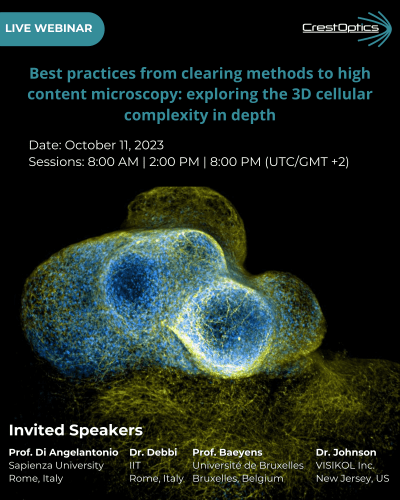CrestOptics ‘Best practices from clearing methods to high content microscopy: exploring the 3D cellular complexity in depth’ webinar
Sessions: 8:00 AM | 2:00 PM | 8:00 PM (UTC/GMT +2)
Date: October 11, 2023
Abstract
Studying the three-dimensional (3D) cellular structure is crucial for gaining a more meaningful understanding of biological systems as it remarkably preserves the physiological characteristics of the cellular architecture. The study of 3D cellular structures has gained increasing significance in recent years due to advances in techniques such as clearing and microscopy. Together, these techniques provide researchers with the tools to deeply visualize complex 3D cellular architectures at high resolution, enabling detailed analysis of cellular structures and functions.
Performing volumetric imaging at a considerable Z-depth is often challenging due to the light-scattering properties and opacity limits of native tissue. To address this problem, Visikol Inc. developed the Visikol HISTO-M which is an optical clearing technique (i.e., the process of making opaque biological structures transparent) designed specifically for 3D cell culture models and plate-based high-throughput processing. During the webinar, the Visikol HISTO-M technique will be described in combination with fluorescent labeling and high-content imaging allowing for more accurate 3D cell culture model characterization and drug screening.
The webinar will also feature highly relevant speakers who have made significant contributions to the clearing and organoid fields: Prof. Nicolas Baeyens,as well as Prof. Silvia Di Angelantonio and her collaborator Dr. Erica Debbi. Prof. Baeyens, a leading scientist in the field of mechanobiology, has developed an advanced clearing protocol that enables the volumetric visualization of the intricate 3D architecture of various organs, such as bones and human teeth. In the webinar, he will present how this clearing method can be applied to study tissues effectively through the detailed analysis of 3D structures. Prof. Di Angelantonio, an expert in developing innovative techniques for generating 3D brain organoids from hiPSCs, together with Dr. Debbi will share ground-breaking research on complex brain organoid structures and their potential applications taking advantage of high-resolution imaging.
In addition to that, you will learn how CrestOptics X-Light V3 Spinning Disk Confocal technology allows the collection and analysis of 3D images of whole cleared samples at a higher resolution than a wide-field microscope and at a faster scan rate than a point-scanning confocal microscope.
Altogether, our joint webinar promises to provide valuable insights into the cutting-edge techniques and applications of clearing methods, and high-content 3D imaging.

